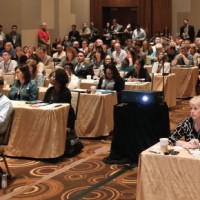
The continuing partnership and professional collaborations that exist between law enforcement and the financial services sectors was a cornerstone of the presentations at the Moneylaundering.com 17th annual Anti-Money Laundering Conference held in Hollywood, Florida this past March. The following highlights are from sessions that included law enforcement officials.
Keynote Address
During his keynote address, J. Chris Warrener, Section Chief, Terrorist Financing Operations Section, Division 13, Federal Bureau of Investigation (FBI), provided an overview of some of the man enforcement and coordination roles the FBI administers. Warrener's areas of focus during the presentation included terrorist threats and funding methods, FBI organizational efforts, and public-private partnership and challenges. The presentation also included an update on the terror financing related activities of Al Qaida, Al-Qaida in the Arabian Peninsula (AQAP), Al Shabaab, the Islamist militants in southern Somalia, and Iranian activities and their proxies.
Elder Abuse: A Prosecutor's Insights
"Preventing Financial Abuse of the Elderly" was a new subject matter area for the conference this year. The law enforcement/prosecution viewpoint was presented by Elizabeth Loewy, an assistant district attorney in the New York County District Attorney's Office. The session, which included speakers from financial institutions, outlined the growth in financial crimes victimizing the elderly. In the United States, it is estimated that elder citizens are financial crimes victims with an annual loss in the amount of $2.9 billion dollars.
Loewy identified the following factors in elder financial abuse law enforcement.
- Could/did the customer consent to the funds transfer?
- Does the customer/victim have testimonial capacity (competence)?
- Can a criminal charge be proven beyond a reasonable doubt, or does this appear to be grounds for a civil action?
Two websites were identified as information resources: www.ncea.aoa.gov and www.apsnetwork.org.
FBI and Bankers Unite to Attack Online Fraud
A session on combating online payment fraud was jointly presented by William Voorhees, Director, Financial Intelligence Unit SVB Financial Group, Stacey Gomer, Analyst, Federal Bureau of Investigation and Kendra Olivares, Manager, Financial Intelligence Unit SVB Financial Group. In outlining the scope of online fraud problem, the presenters stressed that "online crime pays, it's big business." A Javelin study estimated small business fraud totaled $8 billion in 2010. Banks and other providers absorbed $5.43 billion and the cost to victims was $2.61 billion. An Anti-Phishing Working Group study estimated 48 percent of Internet connected machines were infected with malware and eight percent of computers were infected with a banking Trojan or password stealer. A number of remedies for addressing the problem were presented. They include, but are not limited to:
- Target hardening of commercial accounts (they are prime targets)
- Implementing dual control systems
- Client education
- Being organized across the financial institution's enterprise
- Forming a solid anti-fraud partnership with information technology
- Having a plan of attack in place if victimized
- Detecting transaction anomalies
- Tweaking and utilizing existing tools to detect and manage online fraud incidents
AML Framework Design: A Diverse Approach by US Justice Department Official in Concert with Expert Legal Advisor and Bank Executive
John Byrne, CAMS, ACAMS Executive Vice President, led a panel discussion on the "AML Framework for the New Global Financial Crime Paradigm." The panel discussion featured Chip Poncy, U.S. Department of Treasury, David Chenkin, Zeichner Ellman & Krause LLP, and Dan Soto, Ally Financial. The panel examined the changing paradigm of the criminal culture. The changes from past to present include:
- Criminals are transnational and fluid, not regionally based,
- Alliances are being formed with other networks and criminals are not acting alone.
- Criminals are engaging in a wide variety of criminal activities and are not focused on single predicate offense.
The change in the crime culture has resulted in new responses from governments and industry functionaries. The government response has included rule and regulation adjustments for customer due diligence (CDD), beneficial ownership, and cross-border information sharing. The industry response includes:
- Getting back to AML/anti-fraud basics with the new focus on CDD, enhanced due diligence
- Further evolution of the financial crimes intelligence unit (FICU)
- Evaluation of what comes first, money laundering or fraud
- Financial institutions need to reorganize how their FCIU functions and what organizational skill sets are needed by employees to combat global financial crimes.
International FIU Risk Mitigation Thoughts
Jacqueline Somersall-Berry, MPA, CAMS, Director of the St. Kitts-Nevis Financial Intelligence Unit, provided insight into correspondent banking risks in the Caribbean, Somersall-Berry identified the goals of the international criminal as focusing on placing/moving funds quickly and moving funds securely. To mitigate the risk/causation factors, Somersall-Berry suggested:
- Rapid response to behavior associated with risk by flagging certain transactions
- Identifying indirect relationships by documenting suspicious or unusual activity, monitoring and enhancing CDD & know your customer procedures
- Raising the effectiveness of risk mitigation practices by site visits, reviewing country reports and news items
- Building close relationships with competitors and supervisory authorities.
- Identify best practices, share experiences, and encourage good corporate citizenship
- Increasing partnership with law enforcement and supervisory authority.
The United Path Forward
As financial criminals become more sophisticated in the use of technology, terror groups launch international efforts, and lone wolf domestic perpetrators arise, the need for a cooperative effort between law enforcement officials and the private sectors takes on even greater importance. While both sectors have been challenged by global economic problems, the resolve of criminal elements of society to engage in unlawful and dangerous behavior has not abated.
It is incumbent on all members of the anti-money laundering community to continuously renew and reaffirm their commitment to combat financial crime with a never ending commitment to share knowledge, skills and resources while extending existing relationship with a vision of building new bridges for cooperation, communication and coordination.










